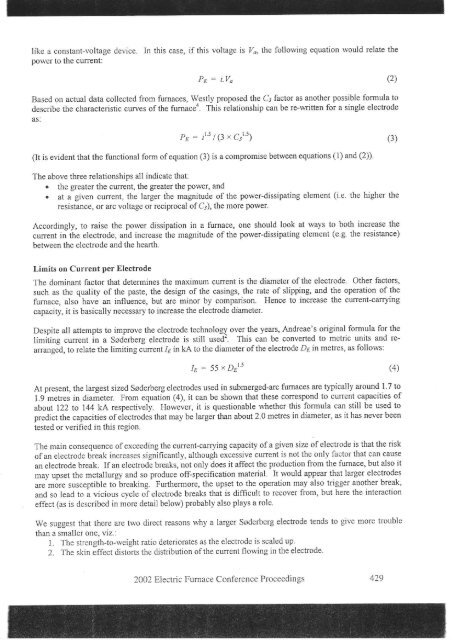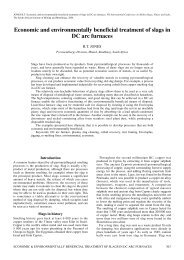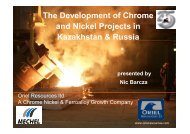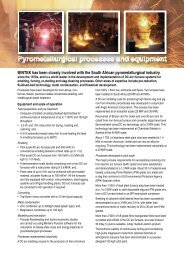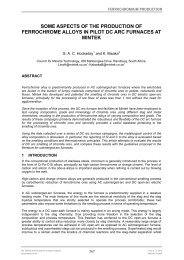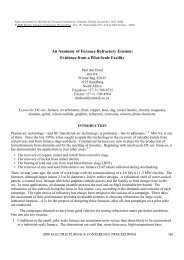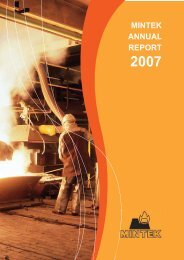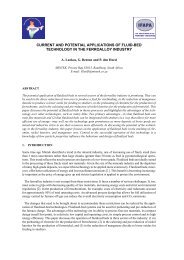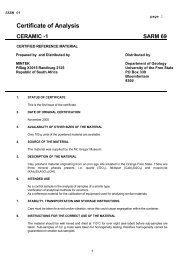the application and scale-up of ac and dc smelting furnaces ... - Mintek
the application and scale-up of ac and dc smelting furnaces ... - Mintek
the application and scale-up of ac and dc smelting furnaces ... - Mintek
Create successful ePaper yourself
Turn your PDF publications into a flip-book with our unique Google optimized e-Paper software.
like a constant-voltage device. In this case, if this voltage is %, <strong>the</strong> followrng equation would relate <strong>the</strong>power to <strong>the</strong> curent:Pr = i.v, (2)Based on <strong>ac</strong>tual data collected from fum<strong>ac</strong>es, Westly proposed <strong>the</strong> C3 f<strong>ac</strong>tor as ano<strong>the</strong>r possible formula todescribe <strong>the</strong> char<strong>ac</strong>teristic curves <strong>of</strong> <strong>the</strong> fum<strong>ac</strong>eo. This relationship can be re-written for a single elechodeas:Ps: its l13"crls1 (3)(It is evident that <strong>the</strong> functional form <strong>of</strong> equation (3) is a compromise between equations (1) <strong>and</strong> (2)).The above three relationships all indicate that:. <strong>the</strong> greater <strong>the</strong> current, <strong>the</strong> greater <strong>the</strong> power, <strong>and</strong>o at a given current, <strong>the</strong> larger ihe magnitude <strong>of</strong> <strong>the</strong> power-dissipating el€ment (i.e. <strong>the</strong> higher <strong>the</strong>resistance, or arc voltage or reciprocal <strong>of</strong> Cj), <strong>the</strong> more power.Accordingly, to raise <strong>the</strong> power dissipation in a fum<strong>ac</strong>e, one should look at ways to both increase <strong>the</strong>current in <strong>the</strong> electrode, <strong>and</strong> ilcrease <strong>the</strong> magnitude <strong>of</strong> <strong>the</strong> power-drssipating element (e.g. <strong>the</strong> resistance)between <strong>the</strong> electrode <strong>and</strong> <strong>the</strong> hearth.Limits on Current per ElectrodeThe dominant f<strong>ac</strong>tor that determines <strong>the</strong> maximum current is <strong>the</strong> diameter <strong>of</strong> <strong>the</strong> electrode. O<strong>the</strong>r f<strong>ac</strong>tors,such as <strong>the</strong> quality <strong>of</strong> <strong>the</strong> paste, <strong>the</strong> design <strong>of</strong> <strong>the</strong> casings, <strong>the</strong> rate <strong>of</strong> slipping, <strong>and</strong> <strong>the</strong> operation <strong>of</strong> <strong>the</strong>fum<strong>ac</strong>e, also have an influence, but are minor by comparison. Hence to increase <strong>the</strong> cimenl-carryingcap<strong>ac</strong>ity, it is basically necessary to increase <strong>the</strong> electrode diameter.Despite all attempts to improve <strong>the</strong> electode technology over <strong>the</strong> years, Andreae's original formula for <strong>the</strong>limrting cunent in a Soderberg electrode is still usedZ. This can be converted to metric units <strong>and</strong> reanangJd,to relate <strong>the</strong> limiting current 1r in kA to <strong>the</strong> diameter <strong>of</strong><strong>the</strong> electrode D6 in metres, as follows:Is = JJ x Puts (4)At present, <strong>the</strong> Iargest sized Soderberg electrodes used in submerged-arc fum<strong>ac</strong>es are tlpically around 1.7 to1.9 metres in diameter. From equation (4), it can be sho*.n that <strong>the</strong>se conespond to current cap<strong>ac</strong>ities <strong>of</strong>aboti 122 to 144 kA respectively. However, it is questionable whe<strong>the</strong>r this formula can still be used topredict <strong>the</strong> cap<strong>ac</strong>ities <strong>of</strong>electrodes that may be larger than about 2.0 metres in diameter, as it has never beentested or verified in this region.The main consequence <strong>of</strong>exceeding <strong>the</strong> current-carrylng cap<strong>ac</strong>rty <strong>of</strong> a given size <strong>of</strong> electrode is that <strong>the</strong> risk<strong>of</strong> an electrode break increases sigrrificantly, although excessive current is not <strong>the</strong> only f<strong>ac</strong>tor that can causean electrode break. If an electrode breaks, not only does it affect <strong>the</strong> production from <strong>the</strong> fum<strong>ac</strong>e, but also itmay <strong>up</strong>set <strong>the</strong> metallurgy <strong>and</strong> so produce <strong>of</strong>f-specificahon material. It would appear that larger electrodesu.r rno." susceptible to breaking. Fur<strong>the</strong>rmore, <strong>the</strong> <strong>up</strong>set to <strong>the</strong> operation may also kigger ano<strong>the</strong>r break,<strong>and</strong> so lead to i vicious cycle <strong>of</strong> electrode breaks that is difficult to recover from, but here <strong>the</strong> inter<strong>ac</strong>tioneffect (as is described in more detail below) probably also plays a role.We suggest that <strong>the</strong>re are fwo direct reasons why a larger Soderberg electrode tends to give more troublethan a smaller one, viz.:1. The strength-to-weight ratio deteriorates as <strong>the</strong> electrode is <strong>scale</strong>d <strong>up</strong>.2. The skin effect distorts <strong>the</strong> distribution <strong>of</strong> <strong>the</strong> current flowing in <strong>the</strong> electrode'2002 Electric Fum<strong>ac</strong>e Conference Proceedings 429


